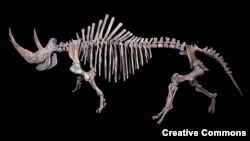A Russian scientist has offered an unprecedented glimpse into the life and ultimate extinction of one of Ice Age Eurasia's most prevalent animals, the woolly rhinoceros.
Gennady Boeskorov concludes that not only did it reproduce slowly, but the squat, 1-2 ton animal had an increasingly tough time slogging through the heavy snow that blanketed northern Asia and Europe 30,000 to 40,000 years ago.
The woolly rhino disappeared in the latter stages of the last glacial age. By then, climate change made a slurry of grassy landscapes from Russia's Far East to Europe's Atlantic coast, where the rhinos roamed alongside other herbivores like woolly mammoths, reindeer, and horses, as well as predators like wolves, cave lions, and hyenas.
Their bulk helped them withstand the Ice Age's extreme temperatures. But that size came at an ultimately fatal cost as temperatures rose, according to Boeskorov:
Boeskorov, of the Russian Academy of Sciences in Yakutsk, based his conclusions on one of four near-fully preserved carcasses of Coelodonta antiquitatis, whose scientific name means "ancient cavity tooth."
The specimen in question is a female that was unearthed near the mouth of a Siberian gold mine in 2007. It sports a similarly thick hide and heavy fur to the better-known woolly mammoth and, like the other specimens, suggests the animal was about 1.5 meters in height, like today's Javan rhinoceros.
Boeskorov's study first appeared earlier this year in "Zoologichesky Zhurnal."
An English-language abstract that appeared in "Biology Bulletin" this month says:
The notion that they reproduced slowly stems in part from the fact that their udders had two nipples, suggesting they generally gave birth to just a single calf.
Woolly rhinos are among the creatures depicted in Ice Age drawings like those found in France's Chauvet Cave.
Scientists first encountered them when a pair of horns was found in 19th-century Russia (and mistaken for giant bird claws).
Siberia is a major source of well-preserved remains, particularly as the long-frozen tundra surrenders carcasses as it thaws as a result of climate change.
-- Andy Heil
Gennady Boeskorov concludes that not only did it reproduce slowly, but the squat, 1-2 ton animal had an increasingly tough time slogging through the heavy snow that blanketed northern Asia and Europe 30,000 to 40,000 years ago.
The woolly rhino disappeared in the latter stages of the last glacial age. By then, climate change made a slurry of grassy landscapes from Russia's Far East to Europe's Atlantic coast, where the rhinos roamed alongside other herbivores like woolly mammoths, reindeer, and horses, as well as predators like wolves, cave lions, and hyenas.
Their bulk helped them withstand the Ice Age's extreme temperatures. But that size came at an ultimately fatal cost as temperatures rose, according to Boeskorov:
As this ice and snow melted, the landscape of the time would also have become increasingly pitted with hollows and boggy banks, forming natural traps that woolly rhinos might have found impassable.
In addition, the natural traps presented certain danger for such a short-legged and heavy creature.
Presumably, this rhinoceros slumped, bogged down and drowned in such a trap.
In addition, the natural traps presented certain danger for such a short-legged and heavy creature.
Presumably, this rhinoceros slumped, bogged down and drowned in such a trap.
Boeskorov, of the Russian Academy of Sciences in Yakutsk, based his conclusions on one of four near-fully preserved carcasses of Coelodonta antiquitatis, whose scientific name means "ancient cavity tooth."
The specimen in question is a female that was unearthed near the mouth of a Siberian gold mine in 2007. It sports a similarly thick hide and heavy fur to the better-known woolly mammoth and, like the other specimens, suggests the animal was about 1.5 meters in height, like today's Javan rhinoceros.
Boeskorov's study first appeared earlier this year in "Zoologichesky Zhurnal."
An English-language abstract that appeared in "Biology Bulletin" this month says:
The results of anatomical and morphological studies of new corpse remains of the fossil woolly rhinoceros found in 2007 in the lower reaches of the Kolyma River are described. These new data provide additional details of the specific features of the structures and sizes of individual body parts of the fossil rhinoceros and allow for several inferences on the specific adaptations of this species to the cold climate of the Ice Age.
The notion that they reproduced slowly stems in part from the fact that their udders had two nipples, suggesting they generally gave birth to just a single calf.
Woolly rhinos are among the creatures depicted in Ice Age drawings like those found in France's Chauvet Cave.
Scientists first encountered them when a pair of horns was found in 19th-century Russia (and mistaken for giant bird claws).
Siberia is a major source of well-preserved remains, particularly as the long-frozen tundra surrenders carcasses as it thaws as a result of climate change.
-- Andy Heil
